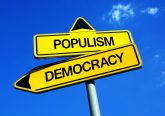 Religious freedom, if it means anything at all, must mean the ability of people of all faiths and none to practice their religion, to form religious associations and perhaps, if necessary, to be exempt from some civil laws, as Sikhs are relieved of the requirement to wear motorcycle helmets. These exemptions should be offered uniformly, based upon the religious beliefs and the impact of the exemption, not on the constitutional status of the religious organization involved. Religious equality means treating all religions the same: Christians, Sikhs, Hindus, Buddhists Muslims and Jews, as well as all denominations within each of them. However, religious establishment (a term that may well be essentially contestable in British constitutional law) necessarily carries privileges with it that cannot be afforded uniformly. These principles came into direct conflict in a recent debate in the House of Lords.
Religious freedom, if it means anything at all, must mean the ability of people of all faiths and none to practice their religion, to form religious associations and perhaps, if necessary, to be exempt from some civil laws, as Sikhs are relieved of the requirement to wear motorcycle helmets. These exemptions should be offered uniformly, based upon the religious beliefs and the impact of the exemption, not on the constitutional status of the religious organization involved. Religious equality means treating all religions the same: Christians, Sikhs, Hindus, Buddhists Muslims and Jews, as well as all denominations within each of them. However, religious establishment (a term that may well be essentially contestable in British constitutional law) necessarily carries privileges with it that cannot be afforded uniformly. These principles came into direct conflict in a recent debate in the House of Lords.
In December, Baroness O’Cathain invoked the ‘negative resolution procedure’ in the House of Lords, seeking to reject regulations promulgated by the Government Equalities Office that would have allowed the registration of civil partnerships in religious premises. Her request was withdrawn after a two and one-half hour debate. Both the fact that the debate took place at all and the arguments that were advanced during its course shed light into a number of obscure nooks and crannies in the British constitution. Among other things, the negative resolution procedure is a rarely used one, through which a peer (or MP) intervenes during the forty days after a statutory instrument has been laid on the table in parliament to force a debate and (potentially) a vote.
One of the most interesting aspect of the debate, however, was in the arguments in favour of the Baroness’ request by the Bishop of Blackburn, who sits in the upper house ex officio as one of the Lords Spiritual (one of the twenty six senior bishops in the Church of England), and Baron Cormack, a long-time member of the joint Ecclesiastical Committee of Parliament, which includes members of both the House of Commons and the House of Lords and is responsible for reviewing internal legislation of the Church of England (Church Measures). The bishop argued,
At the moment, the Church of England, through the General Synod, has not expressed any desire at all for its churches to be used for registering civil partnerships. … [T]here is surely no need for the Church of England to be included in these regulations at all. Indeed, it should be expressly excluded from them; otherwise, it might look as though Parliament is breaking what I understand to be the convention that it legislates for the Church of England only when the church has asked it to? (HL Hansard, 15 December 2011 cols 1427–28)
Similarly, Baron Cormack claimed,
We have a specific provision in this country for the established Church of England. … With the agreement of Parliament, we do not legislate over and above, or directly at, the Church of England; rather, we receive the measures that the church—initially through the Church Assembly but in more recent years through the General Synod—has thought fit to pass. … It is important that the Church of England should have its special position recognised and there should be exemption for it, so that it is up to the synod to decide whether it wishes to pass a measure. (Ibid. cols 1437–38)
These arguments emphasize the special position of the Church of England in the British constitution. The sovereignty or supremacy of parliament can be summarized, as Vernon Bogdanor has pithily put it, in eight words: ‘What the Queen in Parliament enacts is law.’ Here, however, a bishop and a peer seem to be arguing that some questions are outside the jurisdiction of parliament unless the Church of England consents. Contariwise, the arguments seem to imply that only the Church of England, but not any other religious organization, must be consulted before legislation affecting it can be considered by the legislature. These positions seem to contradict fundamental principles of constitutional law. How does all of this fit together?
In 1919 parliament passed the National Assembly (Powers) Act, which provided that the Church of England would be entitled to self regulation by Church Measures, which could be approved or rejected (but not amended) by parliament. In part the act was intended as a remedy for the House of Commons’ tendency in the late-nineteenth and early-twentieth centuries to amend church legislation with provisions that would have disestablished it. As a consequence of the act, the convention described by their lordships, that the church would generally initiate legislation about itself rather than having parliament do so, has become an accepted one. Generally, parliament does not legislate concerning the Church of England in the absence of a Church Measure.
Where the argument fails, however (and indeed is entirely backward) is in its claim of privilege for the church. The 1919 act was not intended to grant any such privilege. Rather it was supposed to make the Church of England more like other churches (while still preserving its establishment). Indeed, its proponents hoped to ‘claim on behalf of the Established Church of England the same liberty as has been enjoyed for over 200 years by the Established Church of Scotland’. (The Church of Scotland, which is arguably established there, has an entirely different relationship with the state from the Church of England. See Iain McLean and Scot Peterson, ‘A Uniform British Establishment’ in Mark Chapman, Judith Maltby and William Whyte, eds., The Established Church: Past, Present and Future (T&T Clark, 2011).)
The regulations that Baroness O’Cathain tried to defeat—regulations that Iain McLean and I supported—permitted religious groups to opt in to a scheme that would allow them to register same-sex civil partnerhips on religious premises. The underlying legislation had been promoted by small religious groups that lack the constitutional stature of the Church of England, including Quakers, Unitarians and Liberal Jews. Baroness O’Cathain argued that the regulations infringed religious freedom, because it might be possible (in her view and that of two leading QCs) for religious organizations to be forced to conduct civil partnership registrations, even though they had moral objections to doing so. The irony is that the Bishop of Blackburn and Baron Cormack supported her position, arguing that the privilege of the Church of England dictated that it should be treated differently from all other churches, as being outside parliament’s authority.
Baroness O’Cathain’s arguments about religious freedom for her own Church of England ran against the arguments of the Quakers, Unitarians and Liberal Jews, that their religious freedom was infringed by not allowing them to register civil partnerships. (Arguments for religious equality were unaffected by either, since both admitted that all religious organizations should be afforded the same opt-in procedure; Baroness O’Cathain simply thought the risk was too great if any organization had the option.) The most important conflict in the arguments, though, was between the baroness and her opponents, on the one hand, and Bishop Blackburn and Lord Cormack on the other. The latter argued for increased religious inequality and privilege for the Church of England, based upon the principle of religious establishment. They did so, quite correctly, on the basis of British constitutional law. But their argument exposes a serious flaw at the heart of English religious establishment: its inconsistency both with equality and with religious freedom.
Iain McLean has again entered the fray, arguing that the upcoming consultation on same-sex marriage will make it necessary for minority religions like Quakers, Unitarians and Liberal Jews to defend the right of other denominations and religions to refuse to participate in marriages of same-sex couples, which they object to on moral grounds, in order to protect religious freedom. But he also claims that this project must, of necessity, ‘blow English-style establishment out of the water’. The courts have offered the Church of England protection from some laws, based upon the fact that they are not a public authority. This protection, in turn, offered a shield against public sector equality duties that Baroness O’Cathain and her supporters so feared. Nevertheless, while principles of religious equality and religious freedom must be protected by all those concerned, religious establishment is no longer viable: the protection offered to the Church of England must be uniform with that offered to all religious faiths. Two of the essential components that offer privilege to the Church of England are the anachronistic presence of twenty-six unelected bishops in the House of Lords and the National Assembly (Powers) Act, above. The solution to this logical conundrum is the elimination of the remaining laws that apply to the Church of England but not to other churches. A move in that direction would be a move toward a more coherent British constitution.
Scot M. Peterson is a lecturer in politics at Balliol College, Oxford.







No Comment